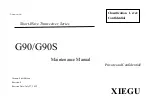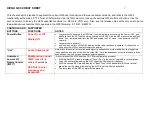
12
MAIN REMOTE CONTROL FUNCTIONS
K
Tuning Up/Down:
When the tuner is in use,
these buttons will tune up or down through the
selected frequency band. If the
Tuner Mode
but-
ton
I
has been pressed or the
Band
button
!
on the front panel was held pressed so that
AUTO
appears in the
Main Information
Display
˜
, pressing either of the buttons will
cause the tuner to seek the next station with
acceptable signal strength for quality reception.
When the
MANUAL
appears in the
Main
Information Display
˜
, pressing these but-
tons will tune stations in single-step increments.
(See page 46 for more information.)
L
OSD Button:
Press this button to activate
the On Screen Display (OSD) system used to set
up or adjust the AVR’s parameters.
M
Dolby Mode Selector:
This button is used
to select one of the available Dolby Surround
processing modes. Each press of this button will
select one of the Dolby Pro Logic IIx modes, Dolby
3 Stereo or Dolby Digital. Note that the Dolby
Digital or Dolby Digital EX is only available with
a digital input selected and the other modes only
as long as a Dolby Digital source is not playing.
See page 33 for the available Dolby surround
mode options.
N
DTS Digital Mode Selector:
When a DTS
source is in use the AVR will select the appropri-
ate mode automatically and no other mode will
be available. Pressing this button will display the
mode currently selected by the AVR´s decoder,
depending on the surround material played and
the speaker setting (see item
6
, page 5). When
a DTS source is not in use, this button has no
function. (See page 22, 33 for the available DTS
options.)
O
Logic 7 Selector:
Press this button to
select one of the available Logic 7 surround
modes. (See page 33 for the available Logic 7
options.)
P
Transport Control Buttons:
These but-
tons do not have any functions for the AVR, but
they may be programmed for the forward/reverse
play operation of a wide variety of CD or DVD
players, and audio or video- cassette recorders.
(See page 48 for more information on program-
ming the remote.)
Q
Light Button:
Press this button to activate
the remote’s built-in backlight for better legibility
of the buttons in a darkened room.
Skip Up/Down Buttons:
These buttons do
not have a direct function with the AVR, but
when used with a compatibly programmed CD or
DVD player/changer they will change the tracks
on the disc currently being played.
Stereo Mode Selector:
Press this button
to select a stereo playback mode. When the but-
ton is pressed so that
DSP SURR OFF
appears in the
Main Information Display
˜
,
the AVR will operate in a bypass mode with true
fully analog, two-channel left/right stereo mode
with no surround processing or bass manage-
ment as opposed to other modes where digital
processing is used. When the button is pressed
so that
SURROUND OFF
appears in the
Main Information Display
˜
, you may enjoy
a two-channel presentation of the sound along
with the benefits of bass management. When
the button is pressed so that
5 C H STEREO
or
7 C H STEREO
appears, the stereo signal
is routed to all five speakers, if installed. (See
page 23 for more information on stereo playback
modes).
DTS Neo:6 Mode Selector:
Pressing this
selector button cycles the AVR through the
various DTS Neo:6 modes, which extract a five-
or seven-channel surround field from two-chan-
nel program material (from PCM source or ana-
log input signal). The first press selects the last
DTS Neo:6 surround mode that was in use, and
each subsequent press selects the next mode in
the following order:
Macro Buttons:
Press these buttons to
store or recall a “Macro”, which is a pre-pro-
grammed sequence of commands stored in the
remote. (See page 51 for more information on
storing and recalling macros.)
!
RDS Select Button:
Press this button to
display the various messages that are part of the
RDS data system of the AVR’s tuner. (See page 47
for more information on RDS).
"
Preset Up/Down:
When the tuner is in
use, press these buttons to scroll through the
stations programmed into the AVR’s memory.
#
Clear Button:
Press this button to clear
incorrect entries when using the remote to directly
enter a radio station’s frequency.
$
Memory Button:
Press this button to enter
a radio station into the AVR’s preset memory. Once
the station's frequency will flash in the
Main
Information Display
˜
, you then have five
seconds to enter a preset memory location using
the
Numeric Keys
H
. (See page 46 for more
information.)
%
Delay Select Button:
This button selects
adjustments to the A/V Sync Delay and the indi-
vidual channel displays. The first press of the but-
ton displays an
A/V SYNC DELAY
message
in the
Lower Display Line
˜
and in the on-
screen display, which means that you may
change the amount of time that all channels are
delayed together behind the video. This enables
you to compensate for the loss of lip sync that
may be caused by digital video processing in
your display or by television stations. To change
the A/V Sync Delay, press the
Set Button
F
while the
A/V SYNC DELAY
message is
visible and then use the
⁄
/
¤
Navigation
Button
E
to change the setting so that the
sound and the video image are in sync. To
change the delay for an individual output chan-
nel, press the
⁄
/
¤
Navigation Button
E
until the desired channel name is shown, and
then press the
Set Button
F
. Use the
⁄
/
¤
Navigation Buttons
E
to change the delay
amount. (See page 26 for more information on
delay options.)
&
Program Button:
This button is used to
begin the process of programming the remote.
Press and hold this button for three seconds to
place the remote in the programming mode.
Once the red LED under the
Set Button
F
lights, release the button. You may then select
from the desired option. (See pages 48 – 58 for
more information on configuring the remote.)
'
Speaker Select:
Press this button to begin
the process of configuring the AVR’s Bass
Management System for use with the type of
speakers used in your system. Once the button
has been pressed, use the
⁄
/
¤
buttons
E
to
select the channel you wish to set up. Press the
Set Button
F
and then select the speaker
type (Large, Small or None) appropriate with the
speaker in use. (See page 21 for more informa-
tion.)
(
Multi-Room:
Press this button to activate
the Multiroom system or to begin the process of
changing the input or volume level for the sec-
ond zone. (See page 43 for more information on
the Multiroom system.)
)
Volume Up/Down:
Press these buttons to
raise or lower the system volume.
DTS Neo:6 MUSIC
DTS Neo:6
MOVIES
Main Remote Control Functions













































